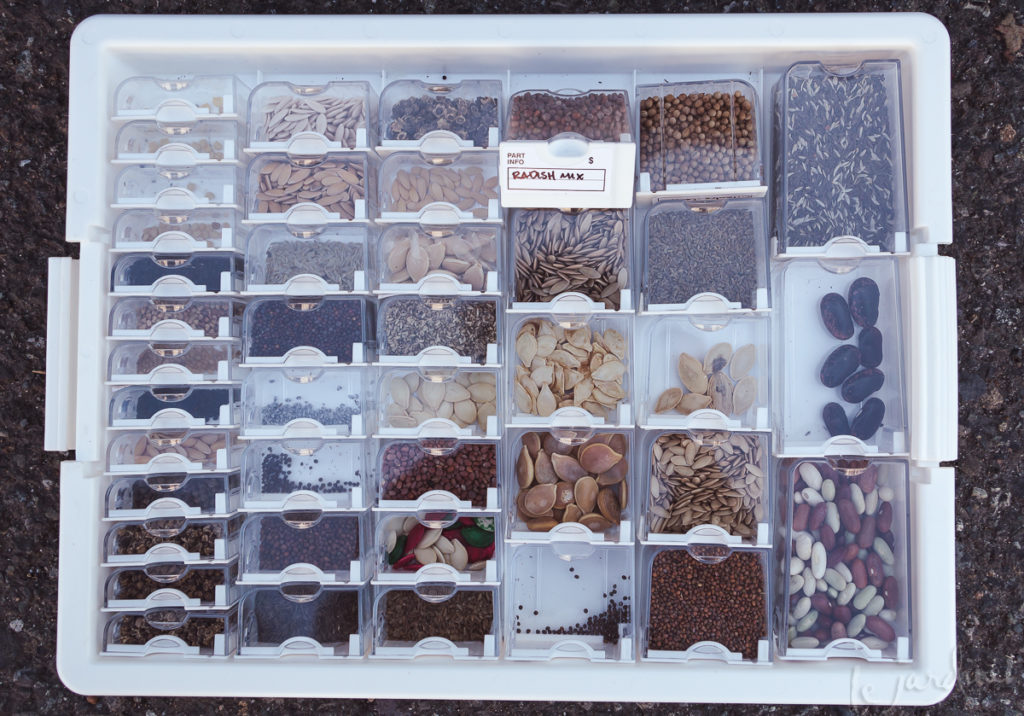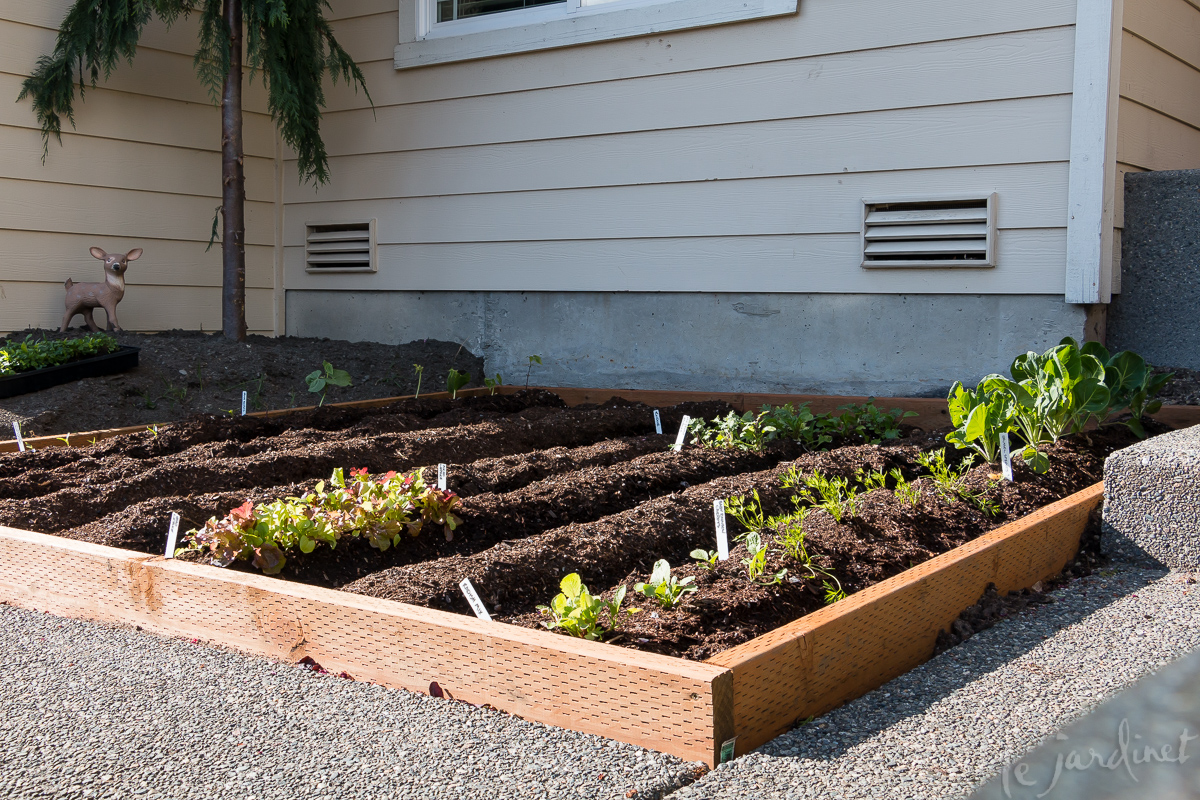Homegrown Heirlooms: 2 chefs share their passion from seed to plate

The most creative chefs aren't afraid to try new flavors or to give familiar recipes a fresh twist. "When you experiment, you learn," commented University of Washington chef Dustin Selner; except he is taking about growing food not just developing new recipes.
Dustin met Colby Crouch at culinary school in Seattle many years ago, where they became firm friends, sharing not only a passion for cooking but also for growing the treasured older varieties of fruit and vegetables. Dustin grew up in Idaho where his dad grew heirloom tomatoes and beans for market, while always saving a portion to use as seed for the following year. This sensible and sustainable approach is one that resonated with Dustin.

Re-thinking foundation planting with the addition of a small, attractive raised bed for vegetables by the front door.
When he later moved into the Crouch family home as " Uncle Dustin" it was natural that he and Colby would start a vegetable garden on the sunny lot. Yet where most homeowners might add a discreet raised bed or two, Colby and Dustin decided to maximize the growing potential throughout the entire garden; front, back, and even a really narrow side garden.
They chose to focus on growing heirloom varieties of vegetables; some such as scarlet runner bean and a ground cherry, have been propagated from seed saved by Dustin's Dad for over 30 years, while a black snap pea has been propagated by a family friend who specializes in rare seed. They also purchased a few seeds from Bakers Creek, an online seed company that specializes in these rare, older varieties. When I asked Colby how he decided what to buy, he said they simply looked at what they already had then pored over the catalog looking for produce that rounded out their selection, appeared intriguing or promised superior flavors.
Experimental set up

A wide range of fruit and vegetables are grown from seed including a French Prescott cantaloupe melon, grown from seed that dates back to the 1860s! Dustin isn't sure if we'll have a hot enough summer in Duvall, WA for them to ripen – but that doesn't mean he isn't going to try (and so am I)!
Their seed starting set up is certainly creative too with seed trays perched on top of an old car in the garage! Rather than purchasing the typical T5 fluorescent bulbs, they made use of some LED grow lights that they already had; the Apache Tech AT600 which offers multi-wave white light as well as rows of enhanced infrared.
I noticed the soil mix didn't look like the typical seed starting mix that I use and they admitted that while they had purchased some bagged potting soil it wasn't cheap – and they had several yards of De Jong's DJ Garden Mix already for their raised beds in the garden, so decided to try that for the seeds. They pre-mixed it with organic EB Stone Tomato and Vegetable fertilizer at a rate slightly lower than that recommended for outdoor growing.
Trial and error showed them that watering the seed trays from above caused the soil to crust and become hydrophobic so began to water from the bottom instead, setting the growing plugs into trays filled with water.
The results?
Well they put my set up (using fluorescent lights and 'proper seed starting soil') to shame!! In just three weeks their seedlings are ready for transplanting and in some instances for hardening off in preparation to go outside! The root development is also remarkable and unlike my spindly seedlings, theirs are robust.
The guys did admit that this custom soil mix isn't ideal for seed starting, although their germination rate has been excellent, but that in future they will probably add some perlite to improve the soil porosity.
Creative Planting Ideas
Their vegetable starts have been integrated throughout the garden rather than in a single dedicated plot, taking advantage of the ornamental and functional characteristics of each crop.
Wild spinach (the original seed was foraged from the Pioneer mountain range in central Idaho and has been propagated by Dustin and his Dad ever since) is sown against a shaded fence where it will grow 10' tall or more and create a leafy screen from the neighbors. (Do note, however, that the flavor may be best in younger leaves, and that this plant can self-sow aggressively). Scarlet runner bean, one of their oldest seed varieties is also against the fence and will be trained along wires to smother the cedar panels in flowers for the hummingbirds followed by edible beans.
In a narrow strip of garden on the property line they have planted an early variety of corn that promises up to eight 7-8" ears per stalk. Their upright habit will create an attractive, seasonal fence between the two homes.
"Geopots are awesome," says Dustin as he showed me the healthy tomatoes, peppers, and strawberries. The breathable fabric "air prunes" plant roots when they reach the edge of the container. This air root pruning process forces the roots to branch out with more fibrous feeder roots, which are more efficient in taking up water and nutrients. The porous fabric also allows air into the root zone and provides great drainage, creating a healthy environment for the roots.
They also have an intriguing idea for training the tomato vines to grow on horizontal trellises or scrogs, a technique often used for growing cannabis to increase yields. I can't wait to go back and see how this works!
Where most homeowners would add ornamental shrubs and perennials by the front door, the guys have claimed this sunny spot for rows of vegetables including microgreens. By framing these in a shallow raised bed the area looks tidy – an important consideration in this attractive suburban neighborhood. They plan to add hoops over the middle section in late fall to extend the harvest season, while Colby's wife, Jessie, has requested some pansies on either side to satisfy her craving for winter color. (Although a self-confessed beginner gardener, Jessies' parents and their garden were once featured on the cover of Sunset magazine!)
A spot under a towering birch tree is home for assorted squash where they can cascade down the gentle slope, and a series of small raised beds against the front fence fence will yield potatoes and other crops.
Not all their produce has been grown from seed, however. Fruit trees (apple, peach, and cherry) and raspberry bushes serve double duty as ornamental and edible plants in the back garden while shade tolerant herbs such as parsley plants have been tucked into an otherwise neglected corner by the back gate.
Future Plans
While Colby has now set aside his career as a professional chef and joined his family millwork business, both he and Dustin still share a dream that one day they will be able to buy 10-20 acres and mass produce these heirloom varieties for sale while saving their own seed, and they would love to be able to use such a space as a platform to teach kids how to grow their own food.
For now though, those lessons start in this family garden in Duvall, WA with Colby and Jessie's two young children. Sweet one year old Kynzie is a willing taste-tester and garden helper, although 8 year old Cooper would still prefer a Chicken McNugget tree!
"I can't always be a chef," says Dustin thoughtfully. "But I can always garden."
Follow their progress on instagram: @crouchfamilyfarms
This post contains affiliate links
Subscribe to Receive Blog Posts
Gardening inspiration delivered right to your inbox from Le Jardinet



